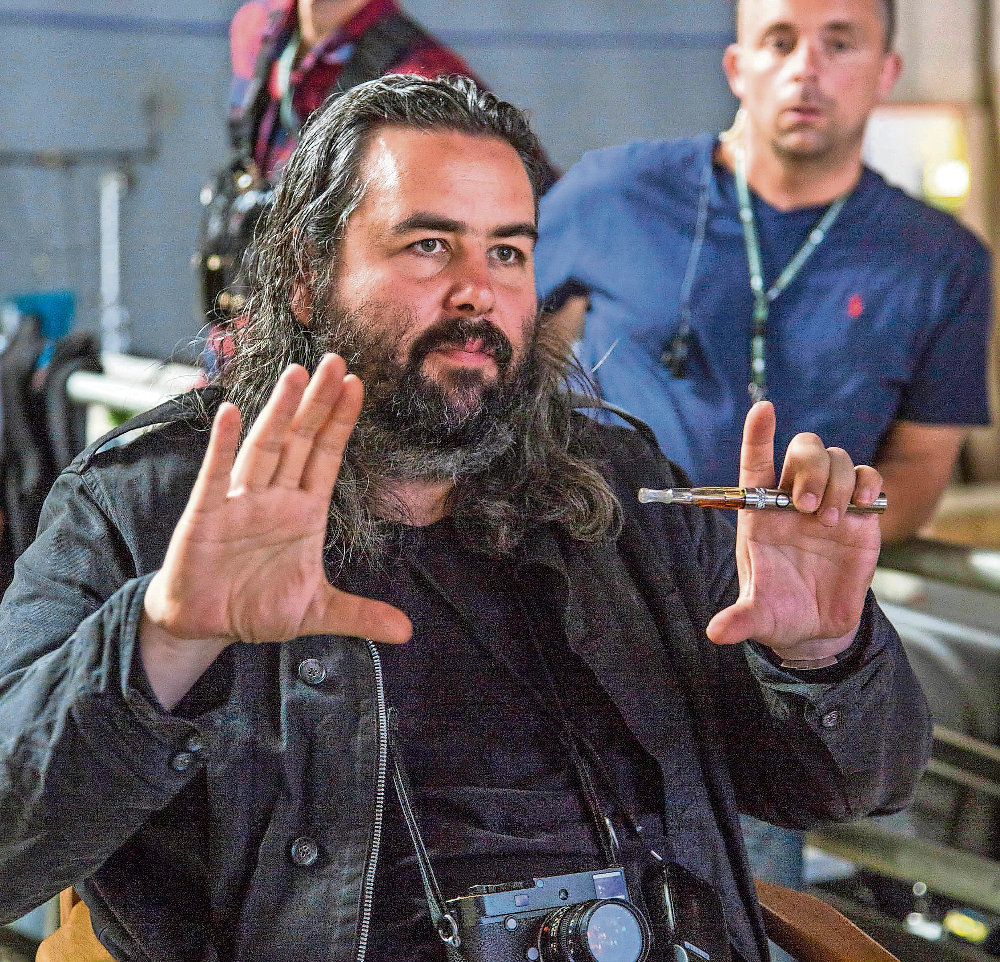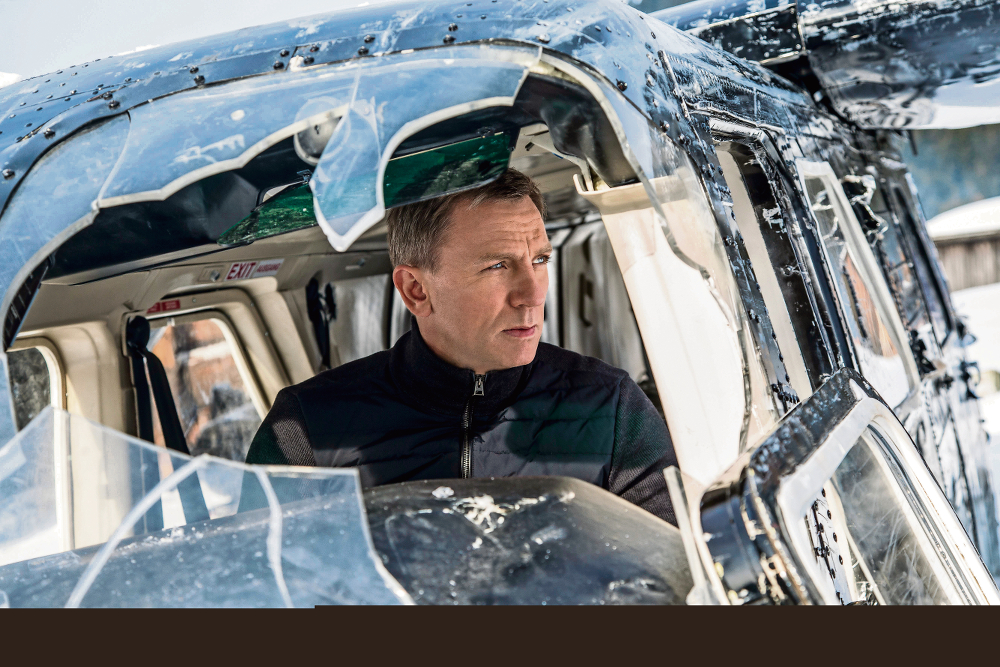Daniel Craig comes out guns blazing after miraculously escaping a plan crash in Spectre.
Director Sam Mendes likes to mix things up. He opened Skyfall, 2012’s $1.1-billion global box office smash, with a thrilling action sequence that travelled many miles across Western Turkey, involving motorcycles, a duel atop a moving train, an enormous digger and some tense sniper action from Miss Moneypenny. For Spectre’s pre-title sequence, he wanted something very different.
“When we did Skyfall, we created a very linear action sequence, a real chase that went from one location to another, very fast, and we ended up shooting over a long distance – Istanbul, Adana and the mountains,” says Mendes. “Spectre was the opposite. I wanted to drop the audience right in the middle of an incredibly atmospheric, hot, dusty, exciting environment.”
He chose a raucous Day of the Dead celebration in Mexico City, which not only offers the audience a visual feast – with thousands of beautifully dressed extras and enormous skeletal puppets – but also a spectacle that echoes the movie’s central theme.
“The celebration of the dead has a link, thematically, to the rest of the movie,” he explains. “What they say of the Day of the Dead is los muertos vivos estan – the dead are alive. Thematically, that is what the movie is about. That hopefully elevates the sequence into being more than just spectacle.”
When putting together a big-budget event picture such as Spectre, especially when it exists in a broader franchise, there is always a danger that filmmakers could fall into the trap of choosing spectacle for its own sake.
“The great danger with Bond is that you have action for action’s sake, and you end up simply striving to be bigger and louder,” Mendes concedes. “But what I wanted to do here was to create something that had atmosphere, beauty and scale. The point was that the character was lost in this kind of vast labyrinth, briefly, and I hope the audience will be fully immersed in it as well.”
Understanding the franchise

Bond film director Sam Mendes. (Jonathan Olley)
Having spent the past five years of his life fully immersed in back-to-back Bond films, Mendes has a deep understanding of the franchise and all its nuances. Another of the series’ defining characteristics, he says, is its ability to straddle different worlds. The narratives are neither pure flights of fancy nor grim and gritty realism.
Instead, they are rooted in reality and yet always remain just beyond our reach; they are glamorous adventures, perennially aspirational and always brimming with beauty and wonder. This fact remained at the forefront of the director’s mind throughout the production.
He cites as a specific example a key scene that unfolds when Daniel Craig’s 007 comes face to face with his nemesis, the mysterious Oberhauser, played by Oscar-winner Christoph Waltz. Bond infiltrates a meeting of the criminal organisation Spectre and Oberhauser emerges from the shadows. The characters lock eyes.
Mendes had to contend with the fact that there have been plenty of Spectre meetings already committed to film, each one right for the time in which it was made. He had to create something new, but that also remained true to the spirit of the series.
“I don’t know who said it but it is the job of the artist to make the familiar strange and the strange familiar,” says Mendes, who won a best director Oscar for 1999’s American Beauty.
“I think that is a great line to take into Bond if you are working on it because you can’t entirely invent things. It is not a fantasy. You are not in a Marvel Comic world or a JK Rowling world. You can’t create things that don’t exist in our own universe. So you have to make the familiar a little bit strange.”
Visiting real-world locations
In the film in general, says Mendes: “There are religious overtones and there are overtones of organised crime and overtones of business enterprise. What they talk about is specific, but they don’t go into too much detail –they briefly mention counterfeit pharmaceuticals, they speak about surveillance, about human trafficking. You get a sense of what they do without it being too specific. I think that is the game you play with Bond. You want just enough information, but not too much.”
In his bid to keep things rooted in the real world, Mendes tries to do as many of his special-effects shots as possible in camera. He is not averse to using computer generated imagery (CGI), but only to amplify what has been shot on location. “The locations are essential,” he says. “We could have done a CG plane chase, for example, but the feeling that you are doing things for real is part of why I make any film, especially a Bond movie.
“I am not somebody who enjoys or who is drawn to making films in green screen,” he continues. “I am all for supplementing real effects with computer-generated enhancement, but you have to base everything you do on some core of reality.”
To do so, notes Mendes, the production must visit real-world locations, where events don’t always work as we might imagine.
“Snow and smoke don’t move as you imagine, water does not move as you imagine,” he explains. “Things are uncontrollable – weather, wind, birds, animals, crowds and vehicles all behave in ways that you can’t anticipate. And it is those imperfections in the scale that make it interesting. They make an audience feel that it is happening in the real world and that it is not a distortion.”
Old-fashioned craftsmanship meets high-tech
Mendes wants to know how his set pieces will look, even if it means building special-effects rigs in miniature, blowing them up and using those as a reference. “That’s what we will do rather than creating something from scratch on a computer,” he says.

Daniel Craig. (Jonathan Olley)
“There is a sense of artistry – an old-fashioned craftsmanship which you can then combine with the latest high-tech, ideas-based, computerised technology in order to supplement that craftsmanship. That’s the perfect blend, in my opinion. Without the hard work and the actual rolling up of your sleeves, and the building of the sets, the movie would feel quite different.”
The filmmakers are certain that Spectre, though in many ways a continuation of Skyfall, will feel different from what has come before. When, in Skyfall, Mendes reintroduced Q and Miss Moneypenny (played by Ben Whishaw and Naomie Harris, respectively), the director imagined personal narratives for the characters – and these now blossom in Spectre.
Skyfall also introduced Ralph Fiennes, who now steps into M’s sizable shoes. “I had cast a new M and a new Q and a new Moneypenny and inherited a great Tanner in [actor] Rory Kinnear,” he says. “I felt that we had established them in the last movie and they were younger than Bond, with the exception of Ralph. They were coming up through the ranks and capable of going out into the field with him and, in Naomie and Ralph’s case, capable of handling a weapon. There were some real options here as to where we could take the characters next.”
This deeper characterisation transfers to the rest of the supporting cast as well, perhaps most notably with the character of Dr Madeleine Swann (Léa Seydoux) and the prime villain, Oberhauser. The former proves a strong match for Bond.
“It is about the life she’s lived,” says Mendes. “In this case, she is the daughter of an assassin. She has grown up around assassins and men who kill. She wants to escape it and she is yoked together, against her will, with an assassin [Bond] who she initially distrusts.”
The “Bond girl”
Her relationship with Bond changes as the film progresses. “They are thrown together by fate and gradually find things in common, because they are both ultimately very similar,” the director notes.
“She also has a deeper motivation. She is on her own journey too. Léa is very still and very mysterious,” he adds. “She has a kind of soulfulness. She is unusual in her beauty. Sometimes she is very cool and distant and other times she really glows. She is a really intriguing figure on screen.”
Mendes is equally enamoured with Waltz, whose character Oberhauser also reveals a fascinating personal story. “As with Javier Bardem in Skyfall, we had Christoph in mind from an early stage. He is a master. His performance is so nuanced and subtle, so still and economical. He never defaults to melodramatics.
“Like everybody else I’ve been blown away by the work he has done in Tarantino’s movies, but also in other movies too. You have to keep reminding yourself, ‘My God, he is so subtle with language, so detailed, and yet he is not working in his first language.’ It’s remarkable.”
Spectre opens in South Africa on November 27